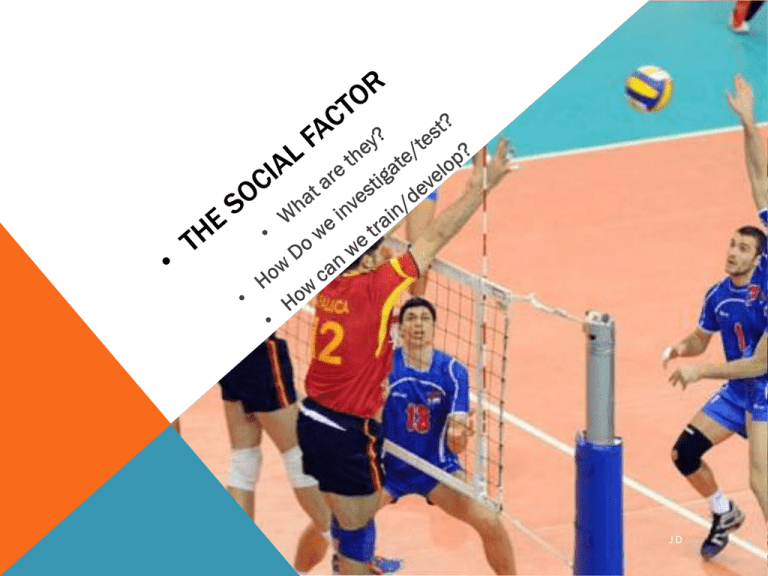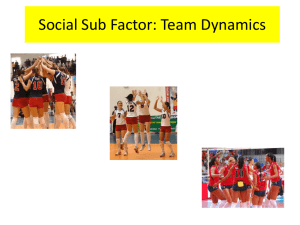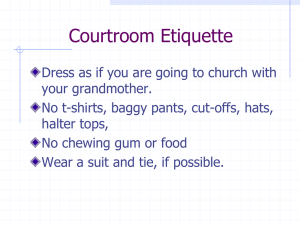The Social Factor - Bannerman High School
advertisement

JD Plagiarism Warning Throughout this power point there are sample answers. Please note that these sample answers are not to be used as your own work they are for reference only. If you fail to comply with this request you will be at risk of failing the course. THE SOCIAL FACTOR THERE ARE THREE MAIN AREAS WITHIN THE SOCIAL FACTOR THESE ARE: GROUP DYNAMICS CULTURAL / SOCIETAL ISSUES ENVIRONMENTAL ISSUES GROUP DYNAMICS GROUP DYNAMICS Co operation Contributing to the team Roles/responsibilities Team dynamics Ethos / atmosphere Communication GROUP TASK As a group decide which is the most important aspect of group dynamics eg. Co-operation. Give two reasons to support your answer Choose a spokesperson for your group to speak in front of the class to share your group’s thoughts. CULTURAL AND SOCIETAL ISSUES CULTURAL AND SOCIETAL ISSUES Inclusion Gender Etiquette Respect for others Respect for self Fair play Motivation, internal and external CULTURAL AND SOCIETAL ISSUES Answer the questions in your jotter 1 – How can you demonstrate etiquette in Volleyball? 2- inclusion is important when playing as a team, why is this? 3 – Give two examples of internal motivation? 4 – Give two examples of external motivation? 5 – Why must you show respect to your team mates? ENVIRONMENTAL ISSUES ENVIRONMENTAL ISSUES Facilities Cost Location Weather ENVIRONMENTAL ISSUES In your jotter write a brief description of how: • Facilities • Cost • Location • Weather Can affect your participation in your chosen sport. INDIVIDUAL TASK Describe how the Social factor impacts your performance during a game of Volleyball, Football or Badminton. (4) The Social Factor had a big impact on my performance during a game of Volleyball. Our team normally has a good dynamic but for some reason we lacked communication during our last match, sometimes two players would try to dig the same ball resulting in a weak set for the spike. Also the setter in the team didn’t fully understand their role so they would quite often leave the second pass and not set the ball for a spike. Prior to this in the warm up some of the players in the team did not take the warm up seriously this led to a negative atmosphere between the players as they did not co operate with the coach or other players. This probably caused the poor communication, disharmony and lack of respect within the team. On a positive note, the second set went slightly better after a team talk. We began to regain respect for each other and also showed proper etiquette to our opponents. This resulted in a much more positive atmosphere where we fully co operated and included each other to win more points than we had previously as everyone knew their role within the team. HOW CAN WE INVESTIGATE/TEST? • Surveys • Coach feedback • Video and audio analysis • Team mates feedback HOW CAN WE INVESTIGATE/TEST? Here is an example of a survey you could undertake in the social factor. Key 1 – very poor, 2 – poor, 3 – average, 4 – good, 5 – excellent A – How good is your team at communicating with each other? 1 2 3 4 5 B – How good is your team at encouraging each other? 1 2 3 4 5 C – How good is your team at helping each other, giving feedback? 1 2 3 4 5 D – How good is your team at organising practices/drills/training? 1 2 3 4 5 E – How good is your team at displaying sportsmanship/etiquette? 1 2 3 4 5 If each person in your team filled this out and the results were collated, your team would gain valuable knowledge about how well you socially interact. TRAINING IN THE SOCIAL FACTOR Watch the following video thinking about how some of the drills done can aid communication and co operation within your team: http://www.ehow.com/video_4989168_run-basicvolleyball-drills.html As a group design your own training drill to work on one of the following aspects from the social factor: • Co operation • Communication • Roles and responsibilities MONITORING TOOLS Training Diary Results from matches Video analysis Observation schedules Coach feedback Team mate feedback WHY MONITOR TRAINING? To check it is effective, relevant to development needs, long term targets. Make sure short term targets are met, progress is being made. Provide motivation to further improve. Make adaptations to training if necessary. Ensure strengths are maintained while weaknesses improved. Revision 1. Name 3 methods you could use to investigate within the social factor? 2. Describe how you carried out one of the methods above for four marks. 3. List two environmental issues from the social factor. 4. Describe one of the environmental issues and describe how it could affect your performance in any sport of your choice. 5. Describe a training drill you have done to develop the social factor and how you would progress it?











